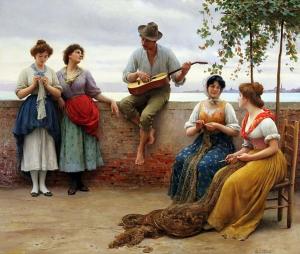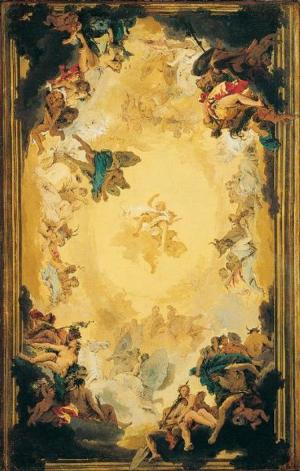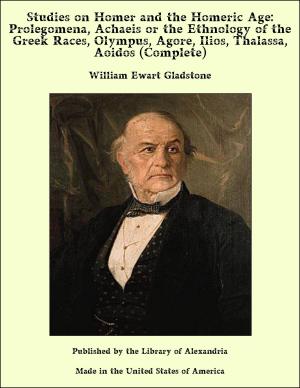The Miller of Old Church
Nonfiction, Religion & Spirituality, New Age, History, Fiction & Literature| Author: | Ellen Anderson Gholson Glasgow | ISBN: | 9781465626325 |
| Publisher: | Library of Alexandria | Publication: | March 8, 2015 |
| Imprint: | Language: | English |
| Author: | Ellen Anderson Gholson Glasgow |
| ISBN: | 9781465626325 |
| Publisher: | Library of Alexandria |
| Publication: | March 8, 2015 |
| Imprint: | |
| Language: | English |
It was past four o'clock on a sunny October day, when a stranger, who had ridden over the "corduroy" road between Applegate and Old Church, dismounted near the cross-roads before the small public house known to its frequenters as Bottom's Ordinary. Standing where the three roads meet at the old turnpike-gate of the county, the square brick building, which had declined through several generations from a chapel into a tavern, had grown at last to resemble the smeared face of a clown under a steeple hat which was worn slightly awry. Originally covered with stucco, the walls had peeled year by year until the dull red of the bricks showed like blotches of paint under a thick coating of powder. Over the wide door two little oblong windows, holding four damaged panes, blinked rakishly from a mat of ivy, which spread from the rotting eaves to the shingled roof, where the slim wooden spire bent under the weight of creeper and innumerable nesting sparrows in spring. After pointing heavenward for half a century, the steeple appeared to have swerved suddenly from its purpose, and to invite now the attention of the wayfarer to the bar beneath. This cheerful room which sprouted, like some grotesque wing, from the right side of the chapel, marked not only a utilitarian triumph in architecture, but served, on market days to attract a larger congregation of the righteous than had ever stood up to sing the doxology in the adjoining place of worship. Good and bad prospects were weighed here, weddings discussed, births and deaths recorded in ever-green memories, and here, also, were reputations demolished and the owners of them hustled with scant ceremony away to perdition. From the open door of the bar on this particular October day, there streamed the ruddy blaze of a fire newly kindled from knots of resinous pine. Against this pleasant background might be discerned now and then the shapeless silhouette of Betsey Bottom, the innkeeper, a soft and capable soul, who, in attaching William Ming some ten years before, had successfully extinguished his identity without materially impairing her own. Bottom's Ordinary had always been ruled by a woman, and it would continue to be so, please God, however loudly a mere Ming might protest to the contrary. In the eyes of her neighbours, a female, right or wrong, was always a female, and this obvious fact, beyond and above any natural two-sided jars of wedlock, sufficed in itself to establish Mrs. Ming as a conjugal martyr. Being an amiable body—peaceably disposed to every living creature, with the exception of William—she had hastened to the door to reprimand him for some trivial neglect of the grey mule, when her glance lighted upon the stranger, who had come a few minutes earlier by the Applegate road. As he was a fine looking man of full habit and some thirty years, her eyes lingered an instant on his face before she turned with the news to her slatternly negro maid who was sousing the floor with a bucket of soapsuds.
It was past four o'clock on a sunny October day, when a stranger, who had ridden over the "corduroy" road between Applegate and Old Church, dismounted near the cross-roads before the small public house known to its frequenters as Bottom's Ordinary. Standing where the three roads meet at the old turnpike-gate of the county, the square brick building, which had declined through several generations from a chapel into a tavern, had grown at last to resemble the smeared face of a clown under a steeple hat which was worn slightly awry. Originally covered with stucco, the walls had peeled year by year until the dull red of the bricks showed like blotches of paint under a thick coating of powder. Over the wide door two little oblong windows, holding four damaged panes, blinked rakishly from a mat of ivy, which spread from the rotting eaves to the shingled roof, where the slim wooden spire bent under the weight of creeper and innumerable nesting sparrows in spring. After pointing heavenward for half a century, the steeple appeared to have swerved suddenly from its purpose, and to invite now the attention of the wayfarer to the bar beneath. This cheerful room which sprouted, like some grotesque wing, from the right side of the chapel, marked not only a utilitarian triumph in architecture, but served, on market days to attract a larger congregation of the righteous than had ever stood up to sing the doxology in the adjoining place of worship. Good and bad prospects were weighed here, weddings discussed, births and deaths recorded in ever-green memories, and here, also, were reputations demolished and the owners of them hustled with scant ceremony away to perdition. From the open door of the bar on this particular October day, there streamed the ruddy blaze of a fire newly kindled from knots of resinous pine. Against this pleasant background might be discerned now and then the shapeless silhouette of Betsey Bottom, the innkeeper, a soft and capable soul, who, in attaching William Ming some ten years before, had successfully extinguished his identity without materially impairing her own. Bottom's Ordinary had always been ruled by a woman, and it would continue to be so, please God, however loudly a mere Ming might protest to the contrary. In the eyes of her neighbours, a female, right or wrong, was always a female, and this obvious fact, beyond and above any natural two-sided jars of wedlock, sufficed in itself to establish Mrs. Ming as a conjugal martyr. Being an amiable body—peaceably disposed to every living creature, with the exception of William—she had hastened to the door to reprimand him for some trivial neglect of the grey mule, when her glance lighted upon the stranger, who had come a few minutes earlier by the Applegate road. As he was a fine looking man of full habit and some thirty years, her eyes lingered an instant on his face before she turned with the news to her slatternly negro maid who was sousing the floor with a bucket of soapsuds.















